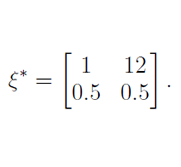Diseños Dπ-óptimos para modelos no lineales heteroscedásticos: un estudio de robustez
Main Article Content
Keywords
Diseños óptimos, matriz de información, teorema de equivalencia, distribuciones a priori, modelos heteroscedásticos
Resumen
Los diseños óptimos son utilizados para determinar las mejores condiciones donde se debe realizar un experimento para obtener ciertas propiedades estadísticas. En los modelos no lineales heteroscedásticos donde la varianza es una función de la media, el criterio de optimalidad depende de la elección de un valor local para los parámetros del modelo. Una forma de evitar esta dependencia es considerar una distribución a priori para el vector de parámetros del modelo e incorporarla en el criterio de optimalidad que se va a optimizar. En este artículo se consideran diseños D-óptimos en modelos no lineales heteroscedásticos cuando se incorpora una distribución a priori asociada a los parámetros del modelo. Se extiende el teorema de equivalencia al considerar el efecto de la distribución a priori. Se propone una metodología para la construcción de distribuciones a priori discretas y continuas. Se muestra, con un ejemplo, cómo a partir de las distribuciones construidas se pueden encontrar diseños óptimos con mayor número de puntos experimentales que los obtenidos con un valor local. La eficiencia de los diseños hallados es muy competitiva comparada con los diseños óptimos locales. Adicionalmente se consideran distribuciones a priori de una familia de escala, y se muestra que los diseños hallados son robustos a la elección de la distribución a priori elegida de esta familia.
Descargas
Referencias
[1] H. Dette and W. Müller, “Optimal designs for regression models with a constant coefficient of variation,” Journal of Statistical Theory and Practice, vol. 7, no. 4, pp. 658–673, 2013. https://doi.org/10.1080/15598608.2013.781833
[2] H. Dette and W. K. Wong, “Optimal Designs When the Variance Is A Function of the Mean,” International Biometric Society, vol. 55, pp.925–929, 1999. https://doi.org/10.1111/j.0006-341X.1999.00925
[3] D. Downing, V. V. Fedorov, and S. Leonov, “Extracting Information from the Variance Function: Optimal Design,” mODa6 Physica, Heidelberg, pp.45–52, 2001. https://doi.org/10.1007/978-3-642-57576-1_6
[4] J. Gaviria and V. López-Ríos, “Locally d-optimal designs with heteroscedasticity: A comparison between two methodologies,” Revista Colombiana de Estadística, vol. 37, no. 1, pp. 93–108, 2014.
[5] J. Burridge and P. Sebastiani, “D-optimal designs for generalised linear models with variance proportional to the square of the mean,” Biometrika, vol. 81, no. 2, pp. 295–304, 1994.
[6] A. C. Atkinson and R. D. Cook, “D-optimum designs for heteroscedastic linear models,” Journal of the American Statistical Association, vol. 90, pp. 204–212, 1995.
[7] H. Dette and W. K. Wong, “Optimal bayesian designs for models with partially specified heteroscedastic structure,” Annals of Statistics, vol. 24, pp. 2108–2127, 1996.
[8] Z. Fang and D. P. Wiens, “Integer-valued, minimax robust designs for estimation and extrapolation in heteroscedastic, approximately linear models,” Journal of the American Statistical Association, vol. 95, pp. 807–818, 2000.
[9] B. P. M. Duarte and W. K. Wong, “Finding Bayesian Optimal Designs for Nonlinear Models: A Semidefinite Programming-Based Approach,” International Statistical Review, vol. 83, no. 2, pp. 239–262, 2015. https://doi.org/10.1111/insr.12073
[10] H. T. Abebe, F. E. S. Tan, G. J. P. V. Breukelen, J. Serroyen, and M. P. F. Berger, “On the Choice of a Prior for Bayesian D-Optimal Designs for the Logistic Regression Model with a Single Predictor,” Communications
in Statistics - Simulation and Computation, vol. 43, no. 7, pp. 1811–1824, 2014. https://doi.org/10.1080/03610918.2012.745556
[11] I. Burghaus and H. Dette, “Optimal designs for nonlinear regression models with respect to non-informative priors,” Journal of Statistical Planning and Inference, vol. 154, pp. 12–25, 2014. https://doi.org/10.1016/j.jspi.2014.05.009
[12] M. Buzoianu and J. B. Kadane, “Optimal Bayesian Design for Patient Selection in a Clinical Study,” Biometrics, vol. 65, no. 3, pp. 12–25, 2009. https://doi.org/10.1111/j.1541-0420.2008.01156.x
[13] D. Braess and H. Dette, “On the number of support points of maximin and bayesian optimal designs,” Ann. Statist., vol. 35, no. 2, pp. 772–792, 04 2007. https://doi.org/10.1214/009053606000001307
[14] D. C. Woods, A. M. Overstall, M. Adamou, and T. W. Waite, “Bayesian design of experiments for generalized linear models and dimensional analysis with industrial and scientific application,” Quality Engineering, vol. 29, no. 1, pp. 91–103, 2017. https://doi.org/10.1080/08982112.2016.1246045
[15] M. Goudarzi, “Bayesian optimal design for nonnegative binomial regression model with uniform prior,” J Adv Pharm Edu Res, vol. 9, no. S2, pp. 52–55, 2019.
[16] O. A. Bodunwa, O. K. y Fasoranbaku, “D-optimal design in linear model with different heteroscedasticity structures,” International Journal of Statistics and Probability, vol. 9, no. 2, pp. 7–12, 2020. https://doi.org/ijspv9n2p7
[17] V. I. Mosquera-Benitez, J. C. y López-Ríos, “Efecto de distribuciones a priori en los diseños d-óptimos bayesianos para un modelo no lineal correlacionado,” Ciencia en Desarrollo, vol. 10, no. 2, pp. 165–178, 2019. https://doi.org/10.19053/01217488.v10.n2.2019.9504
[18] W. K. Duarte, B. P. M. y Wong, “Finding bayesian optimal designs for nonlinear models: A semidefinite programming-based approach,” Int Stat Rev., vol. 83, no. 2, pp. 239–262, 2015. https://doi.org/10.1111/insr.12073
[19] H. Abebe, F. Tan, G. Breukelen, and M. Berger, “Jmasm45: A computer program for bayesian d-optimal binary repeated measurements designs (matlab),” Journal of Modern Applied Statistical Methods, vol. 16, no. 1, pp. 689–721, 05 2017. https://doi.org/10.22237/jmasm/1493599020
[20] C. Ritz and J. Streibig, Nonlinear Regression with R. Springer, New York, 2008.
[21] V. I. López-Ríos and R. Ramos, “Una introducción a los diseños óptimos,” Revista Colombiana de Estadística, vol. 30, no. 1, pp. 37–51, 2007.
[22] J. Kiefer and J. Wolfowitz, “The equivalence of two extremum problems,” Canadian Journal of Mathematics, vol. 12, no. 1, pp. 363–366, 1960.
[23] V. López-Ríos, Diseños óptimos para discriminación y estimación en modelos no lineales. Guanajuato, México: Centro de Investigación en Matemáticas A.C., 2008.
[24] C. Patiño, “Diseños D_-óptimos para modelos no lineales heteroscedásticos con inforación a priori,” Master’s thesis, Universidad Nacional de Colombia, 2017.
[25] R Core Team, R: A Language and Environment for Statistical Computing, R Foundation for Statistical Computing, Vienna, Austria, 2017. http://www.R-project.org/
[26] S. Rana, H. Midi, and A. Imon, “Robust wild bootstrap for stabilizing the variance of parameter estimates in heteroscedastic regression models in the presenceof outliers,” Mathematical Problems in Engineering, vol. 95, 2012.

